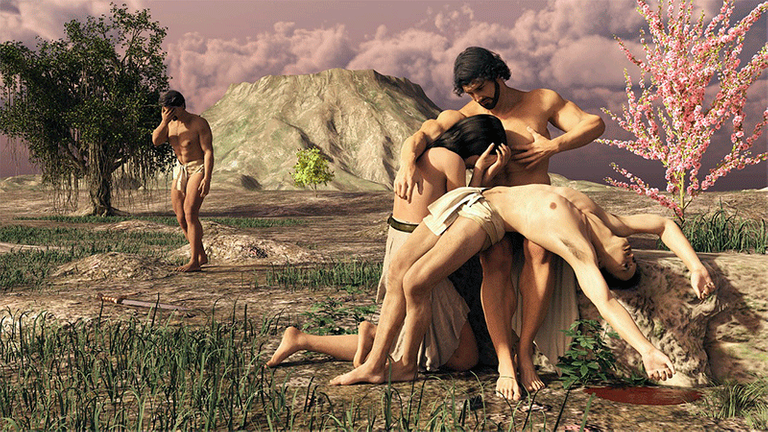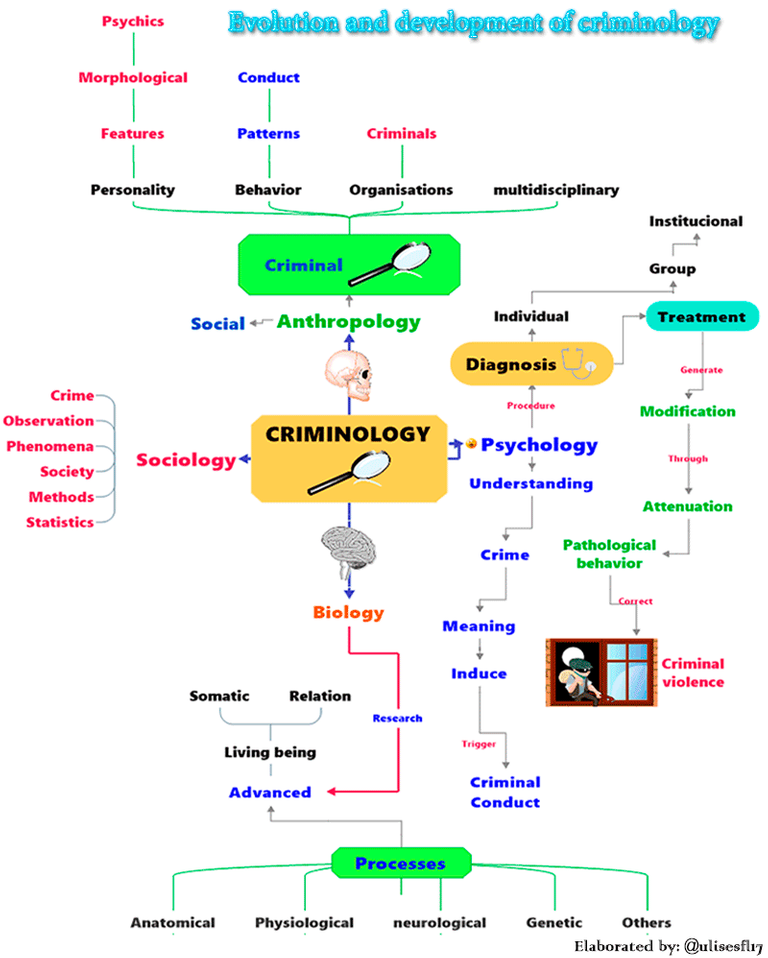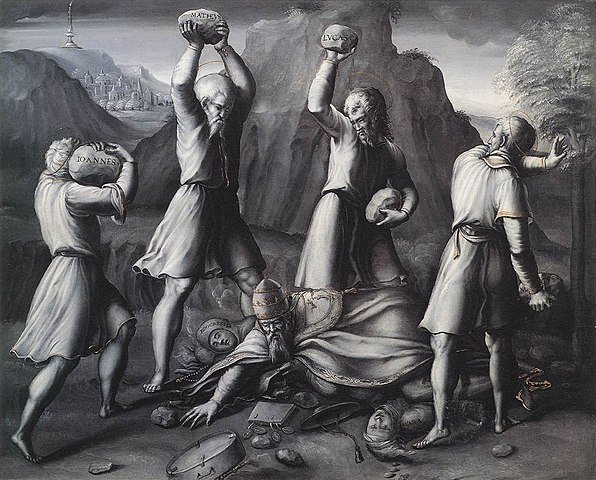Rehearsal of Human Criminal Behavior
(Edited)
Ulises Flores
01/10/2019
¡Greetings dear stem-reader!
This is a modified text from an essay on criminology, where I describe aspects of human criminal behavior as pathology. The post is structured with didactic resources, brief contextualization where the pluridisciplinary approach that has contributed to this scientific discipline is outlined, the evolutionary process as a science itself, some identification methods to establish criminal responsibility and sanction; also, the scientific discursive contrast where criminological science begins to form, ends with the conclusions of the study.
General Context
While it is difficult to determine how old Cain was when he murdered his brother Abel, it is more complex to understand how the events occurred. What are the reasons for the deviant action? Did the perpetrator think about the consequences? What factors influenced the criminal action?
Depending on the angle and perspective in which it is analyzed, there are many questions about a criminal personality. However, what we do have in reference is that it was the first human being who kills another individual. Thus, the criminal record of humanity is opened with the fratricide against Abel.

Attribution: Vilius Alvydas Bulotas Public domain image, hosted at Pixabay.com Cain became the world's first assassin by killing his brother Abel on the slopes of Mount Qasiun, north of Damascus, Syrian territory.
Later on, the biblical account describes that God with his omnipresent quality establishes responsibility for the fact and censors the conduct of the offender by imposing the respective punishment. This divine verdict would mark the beginning of the rejection of all violent and criminal conduct in humanity.
Multidisciplinary approach
On the basis of the foregoing, historical, cultural, social, axiological and spiritual, criminal conduct is rejected; hence the existence of a legislative scaffolding that has at its disposal mechanisms and instruments to establish typicity (action described in the law), anti-juricity (action or omission contrary to the law) and culpability to establish whether or not to sanction.
For almost a century, in the path of due process, the contribution of science has become more and more relevant. Multidisciplinary taxation integrates approaches such as anthropology, biology, medicine, neurophysiology, endocrinology, genetics, biochemistry, ethology, psychology, sociology and other scientific specialties underlying the study of individuals' antisocial behaviors.
The evolution of criminology
The epistemological weight of the historical tradition of early violent behavior is not fortuitous, physical anthropology took the first steps to be configured as social anthropology and took shape to become criminal anthropology, which under the influence of biological positivism is called criminological anthropology. In this way, criminology originates and evolves, a branch of science in charge of studying the biosycho-social factors of criminality.
According to the circumstances and phenomenological aspects, the social and structural causes of the facts derived from delinquent behaviour were studied from scientific approaches in which it was believed that the delinquent person was a species of human being different from Homo sapiens and that this abnormal genus could be the missing link that has been so much sought in the evolutionary chain of man.
Route of criminological science
In fact, the most positivist currents of medicine and biology made considerable efforts to try to obtain results that would lead them to demonstrate and explain that criminal actions have their cause in organic anomalies. Specialists with extensive experience in criminal psychology such as Soria Verde Miguel A. and Dolores Sáiz Roca (2005) have carried out several studies on the subject and agree that criminal behaviour has its origin in the genetic constitution. Let us review the following representative diagram with some evaluative elements according to the scientific fields.

Own diagramming
Evolution of the identification method
The etiological understanding of human criminal behavior has solid theoretical, experimental and interdisciplinary consensus bases that have been structured for centuries; the cultural and traditional registers of regions and localities in historical times are worthy of mention to understand the scientific evolution of this process.

Attribution: Diomede CC BY-SA 3.0 image, hosted at commons.wikimedia.org
Thus, a tribe on the immense island of New Guinea is known for its ancestral practice of establishing criminal responsibility in the event of a homicide. The method of carrying out the vigil of the deceased in public place and placing in his mouth (lips) a nut of betel fruit (Areca catechu), a robust tree of the family Arecaceae (palm tree) that can surpass 30 meters in height. The truth is that drupa contains powerful metabolites with hallucinogenic, medicinal and therapeutic properties, among others.
Since this plant was considered a sacred panacea by the community, it was believed that the corpse would spit out the walnut if the perpetrator was present. In this sense, the person responsible for the act avoids attending and in his attempt to evade justice, he ends up being pointed out and the list of suspects is reduced, since the psychological impact of guilt and fear of being discovered frightens the perpetrator.





Attribution: Gerd Altmann Public domain image, hosted at Pixabay.com Depending on the method used to identify or know a person, there can be high margins of error in the final result.
Of course, the method of announcing the collection of DNA samples when an assassination of an influential person in society occurred is also close to the outlandish previous method. And it is that the practice of pointing out without conclusive evidentiary elements dates from primitive civilization, has its passage through the Babylonian, Mesopotamian, Macedonian, Greek, Roman empires and extends through colonial and modern monarchies, in these the abominable methods of the Holy Inquisition of the Catholic Church and other conventional systems to the present day.
Consequently, this evolutionary journey is perceived that from any time societies have been concerned with creating methods that allow them to identify the person responsible for a crime, thus, judge and punish the misconduct. Other factors deriving from the above were social, moral, religious, cultural, racial and physiognomic aspects. For example, the population of color in racist and affluent societies generally presents relevant statistical indices. In many cases having a certain physical appearance or dressing in a certain way is enough to be suspicious or pointed out...
Scientific Discussion
A set of approaches with argumentative rigor and scientific basis are found in the studies of Giovanni Battista della Porta (1535 - 1615), this Italian researcher developed a series of experiments to determine the qualities of people by observing their aptitudinal bodily attributes. He was followed by Johann Kaspar Lavater (1741-1801) who made more inclined contributions to physical traits:
The art of knowing men through physiognomy (1775-1778) that with its description of men of natural evil "oblique nose in relation to the face, small deformed face and saffron color", we will probably find the clearest inspiration of the profile of the "born criminal".... Source

Attribution: Gerd Altmann Public domain image, hosted at Pixabay.com Multidisciplinary discussion among researchers for consensus on the methods, procedures and results obtained.
These postulates would take shape and generate various theories, including phrenology, which stated that according to certain outstanding areas (relief) in the brain, it was thought that they had certain conduct and mental body competitions. In this way, it was inferred that a person would have x instincts and therefore good or bad behavior.
One of the pioneers and main defender of this theory was the German doctor Franz Gall (1758-1828), argued that each brain zone has certain mental faculties and that the morphology of this organ determines the volume of its mass; among the stimuli - thoughts that he described counts caution, cunning, vanity.... He wrote practically the first text with scientific rigor in criminal psychology.
Displaced the era of phrenology and physiognomy that had a certain proximity with the rough pseudoscientific methods treated in previous paragraphs; at the end of the XIX century the criminological field takes a leap with the approach of systematic and experimental observation of the scientific method. Cesare Lombroso, this anthropologist of Italian origin, revolutionized with conclusive studies and research with scientists from other branches, concluding on the pre-existence of a biological factor with special characteristics that leads a person to emerge his criminal behavior.

Attribution: Gerd Altmann Public domain image, hosted at Pixabay.com Throughout this process and multidisciplinary gear, science has advanced with the maturation of criminology as a criminal specialty that studies crime, victim, victimizer and environment.
This author does not diminish the importance of the multifactorial elements of environmental, social, cultural order, among others. And it is that its base was based on works in situ where it carefully evaluated 66 skulls of deceased delinquents who had gained police and judicial renown for their extensive files. Not satisfied with the results, it continues with anthropometric and physiognomic observations of 832 other individuals with similar criminal profiles. In summary, he will infer that there are six types of criminals, all of pathological origin.
Conclusions
The evolution of the criminological sciences, today called criminology, has an epistemological, experimental and socio-cultural flow that reveals the human instinct to discover, identify, judge, sanction and prevent about perpetrators and victims, about ideas and systematization, between facts and results, as well as knowledge for the administration of justice.
If logic, reason, morals, customs, society and culture manifest that criminal behavior is the product of learned voluntary behaviors, an emerging science is deepening studies to reveal the real origin of criminal behavior. From the perspective of the father of criminology, all criminal behavior is due to a biogenetic anomaly reinforced by multifactorial factors. In successive postures, the subject matter of study and discussion will be expanded and detailed.
▂▃▅▆▇█ References █▇▆▅▃▂
- Criminal behavior, a psychological perspective Link
- Criminal profiles, a tour of the dark side of the human being Link
- Criminal Psychology Link
- Soria Verde Miguel A. and Dolores Sáiz Roca (2005) Criminal Psychology Link

Resources
The author (@ulisesfl17) made the conceptual map with Mindjet MindManager 2018.𝑻𝒉𝒂𝒏𝒌 𝒚𝒐𝒖 𝒇𝒐𝒓 𝒕𝒉𝒆 𝒓𝒆𝒂𝒅𝒊𝒏𝒈 𝒂𝒏𝒅 𝒚𝒐𝒖𝒓 𝒂𝒔𝒔𝒆𝒔𝒔𝒎𝒆𝒏𝒕
steemstem
psychology
science
creativecoin
neoxian
oc
palnet
lifestyle
familyprotection
stem
ecotrain
0
0
0.000
This post has been voted on by the SteemSTEM curation team and voting trail. It is elligible for support from @curie and @minnowbooster.
If you appreciate the work we are doing, then consider supporting our witness @stem.witness. Additional witness support to the curie witness would be appreciated as well.
For additional information please join us on the SteemSTEM discord and to get to know the rest of the community!
Thanks for having used the steemstem.io app. This granted you a stronger support from SteemSTEM. Note that including @steemstem in the list of beneficiaries of this post could have yielded an even more important support.
Thank you for the valuable recognition and support given to my publication.
Blessings to the project #steemstem.
Hello @ulisesfl17 😊
I saw your post early this morning and ever since I have be very eager to read it. I am finally here! I must say that I am very impressed by your introduction to this theme. What a stunning way to open the topic of criminality: with the instance of Cain & Abel. Simply beautiful. Further, let me also compliment the images you selected to illustrate your post. Very, very tasteful!
There are many aspects of your write-up which drew my attention. For example, your citation of the psychologists Soria Verde and Dolores Sáiz, which puts forward their conclusion about criminal behaviour having its origins in genetic constitution.
Which biological factors do they pinpoint as originators of criminal behaviour? And what criminal behaviours in particular?
The processes you displayed at the bottom of your diagram indicate: anatomical, physiological, neurological, genetic and others, as constituting aspects of criminality. Does this suggest criminals are anatomically different from non-criminals?
Despite having gone through and exploring the shortfalls of phrenology and physiognomy, the conclusion of your post ends presenting Lombroso’s idea that genetic factors are the main culprit of criminal conduct.
Despite highly influential (at the time) evidence demonstrates that Lombrosos’s theories were rather too simple and based on subjective observations, with very, very limited scientific basis.
Nowadays, biological and physical defects and disadvantages are rather regarded as symptoms of criminal activity, not the cause of it. That’s why I am curious (and concerned) about the conclusions of the modern day psychologists you described here.
As far as I’m aware, it is The Social Learning Theory which delivers the most reliable and valid argument for explaining criminal behaviour in general (not all) at present. To bring back the idea that criminality arises from a defective biology, not only prompts serious challenges for matters of moral agency and legal responsibility, but also brings back a notion that underwent serious criticism even back in the day.
I see you will continue to discuss this topic in future posts. I very much look forward to it 😊
Finally, I found it very interesting to learn about the New Guinea practice of establishing Criminal Responsibility. Human nature has indeed a sense of fairness and, therefore, accountability deeply embedded in it.
Thank you for this fascinating journey through Criminology Ulisses. Your article really sparked some thinking at this end!
All the best to you,
Abigail
Hi @abigail-dantes. It's a real honour to have you visiting my blog.
The drinking of different documentary sources with theoretical currents that are or differ partially or totally in their postulates, leaves in the researcher or studious a subjective way to define. The approach of psychology to the industry, educational system, labor and military environment... and to the controversial legislative and justice systems properly; they dealt with and have been adjusting in the establishment of limits between logic, reason and madness, to determine whether or not there is responsibility in the commission of a criminal act and the causal factors that drove it.
The understanding of human criminal action is a complex phenomenon in which different scientific disciplines have made important theoretical and practical contributions with respect to its understanding, evaluation and treatment. The way things have been going is not at all easy because at each stage and temporal moment of the investigations there has been more opposition than consensus when it comes to exploring the field of study and the final conclusions.
According to the authors and according to my content analysis, there is a need to observe the units of study (human behaviour) taking into consideration biological, psychological, sociological and environmental factors; this multidisciplinary and integrative vision represents an approach to a more effective method for the establishment or not of criminal responsibility in a perpetrator.
As this is a study that requires a thorough documentary review and debate for subsequent conclusion, I presented the following advance in this post, as I am a student of the course of criminology at the Faculty of Law of the University of Yacambú, as well as a public security officer in retirement with several years of experience in penitentiary matters, police and public order. In this essay I incorporate part of that experience and relate it to theory. Neurological, cranial, physiognomic and other anomalies, as well as social, economic, cultural and environmental aspects are factors worth taking into account in the study of criminal behavior. Later, I will advance in the considerations of my documentary review and academic year.
As it is an academic essay, I end it with some subjective considerations and point of view that I have structured according to the analysis of the revised documentary material. Of course, it does not exhaust the broad field of research. I am currently reviewing more bibliographic sources and relating them to the subjective position that human criminal behavior has an interesting bio-genetic and pathological link.
Your interest in this publication is a sign of motivation, enthusiasm and commitment to continue with the publication of my academic work.
Thank you for your valuable input, comments and interest in the thematic sequel.
Your valuable comments are important to improve my ability to write articles with scientific input. So I appreciate those details that contribute to my growth as a writer.
I was kind of amused to start your very interesting post with a tale (yes, I personally do not buy the Cain and Abel story).
On a more serious matter, I am quite convinced the environment in which anyone evolves plays a big role. I am quite convinced that someone with some "born-killer" aptitudes could end as a nicely-behaving human if evolving in an appropriate environment, and vice versa: someone could get crazy if he is surrounded by the wrong people. Of course, I have nothing to back up my naive thoughts. I however find it weird that in your post, everything is reduced to biological factors.
Somehow, I tend to agree with @abigail-dantes :)
Hello @lemouth.
The first or second paragraph of the thematic introduction to my publications, generally I do some mythological, legendary, historical story or that is sprinkled of humorous interest. However, I clarify the context and frame the differentiation between the previous plane and scientific arenas.
The field of criminology is so extensive that being interdisciplinary it lacks integration of other sciences to obtain more effective results. Hence it is said to be a young science that will never age because it is constantly evolving and progressing. Meanwhile, this essay is a fragment of an academic work that I share in the form of a post. In it I subjectively make some considerations according to the specialized literature that I have reviewed.
From my own experience and also from documentary references, I know that external factors, being precisely sociology the one in charge of the study of multiple social and environmental factors that are generally linked to criminal behavior.
Between disciplines such as criminal psychology and sociology are precisely in charge of studying this type of behavior in order to establish causal analysis that allows following a corrective treatment. However, to deal with such a complex and at the same time controversial topic from an interdisciplinary point of view in an expansive way in a single article is extremely ambitious. I have not yet reached that synthetic capacity.
However, it helps me to better understand the structuring of the title and the scope or delimitation of the post. I only made reference that the topic will continue, but I did not make it clear that in its content I gather the contributions of the positivist school and particularly of Cesare Lombroso.
Your valuable comments are important to improve my ability to write articles with scientific input. So I appreciate those details that contribute to my growth as a writer.
Oh I didn't know that. I think that it is the first time I read something from you (at least as I remember).
Ah I understand now. Therefore, I guess I will need to wait a little bit before you start discussing my points. That's fair enough, as I am a patient person :D
I am thus looking forward to the next episode!
Hey @lemouth,
I think you're right about that, because here, too, you can draw on science and say that "unhealthy behaviour" of living beings most likely will become "healthy behaviour" when the framework in which they move is changed. Create an environment that is good for coexistence and culture and the participants in the system adapt. Create a difficult, mono-environment where strict survival seems to be at stake and you also have participants adapted to that environment. Even genes adapt to their environment - is what I have read somewhere - and are not "static". Everything is an interplay of multiple factors and this interplay is so complex that mono-causality is no longer an option in the latest sciences anyway.
Thanks for agreeing with my guesses (which sounds quite logical to me, but human logics is not science :) ).
I think one does not exclude the other :) For example, a fisher man living all his life at the shore does not use data (quantitative scientific evidence) to make his decisions but his experience with the weather and the sea. So we people use our life experience where we may have known a person changing "from Saulus to Paulus", readjusting his lifestyle from a former criminal to a non criminal.
I agree with this. This is clearly a combination of different parameters and which one dominates is probably also an individual-dependent statement :)
Congratulations @ulisesfl17! You have completed the following achievement on the Steem blockchain and have been rewarded with new badge(s) :
You can view your badges on your Steem Board and compare to others on the Steem Ranking
If you no longer want to receive notifications, reply to this comment with the word
STOPVote for @Steemitboard as a witness to get one more award and increased upvotes!
Greetings. Thank you for the valuable recognition and support given to my blog.
Hi Ulises,
I am refering to this paragraph of yours:
I think the latest science is beyond the point of giving a monocausal hypothesis for anything, be it psychological or physiological. Since I cannot read your sources, I assume that the phrase "that considerable efforts have been made" to do research, the result of which is already determined, does not correspond to the real purpose of research. In the strictest sense, research is always open-ended. Anyone who hopes for a result that already in his mind tends towards one side will always manipulate his own research.
I assume that it is a formulation chosen by you and I interpret your wish that the result should be such that criminal behaviour has its origin in the genetic constitution. Do I see that correctly?
If so, would my question be, why is this result important to you?
Another question would be, put the case, this result would prevail: what would be the consequence then? An intervention in the genome?
For my part, I question whether a biologistic view or discipline that seems so far advanced, as you suggest here, is actually interested in inter-faculty collaboration or whether it is rather a field of research of its own working for itself. "Interdiscipline" is a popular buzzword today, but as far as I can tell, it is rarely used in practice.
Please name concrete research teams or research projects that work interdisciplinary with other teams not working in their own field. Where, for example, are sociologists, biologists, psychologists and others active as a designated, named team discussing and documenting their work as an open end question?
With whom do the scientists named by you who come from another discipline work together?
At present, we have clearly separated the biological, psychological, social and criminal treatment of offenders. If a research team were interested in interdisciplinarity, for example, the topic would be "Interdisciplinary research in the criminological environment", but not "agreement that criminal behaviour has its origin in the genetic constitution."
Please see my comment not as personal, as I don't know you but I am concerned about a perceived overhang which points towards a comeback of biologistical views. I may be wrong on that.
Hi @erh.germany. My name is Ulysses. I'm from Venezuela.
Delighted of your participation and interest in the content of this post. As well, it has been pointed out by the users (@abigail-dantes and @lemouth), as well as the introduction, development and considerations of this post, is a complex problem of multifactorial order. Now, the content corresponds to an academic work that I did in compliance with an activity in the subject of criminology of the law faculty. Being of an academic nature and where I took the liberty of reviewing the sources cited, most of them positivist, the analytical interpretation has a considerable subjective burden.
Numerous studies have attempted to search for and relate the crime and the criminal behaviour of the offender with a genetic explanation of a hereditary nature; although there are other components under study. There are theories that support the transmission of behavioral elements such as aggressiveness, excitability, violence, etc. In order to support their thesis, the followers of this trend have based themselves on three basic types of studies: genealogical, statistical and biological. In the latter, they are advancing with research related to the karyotype. Source
In future publications, I will be more careful to structure the title and specify the scope of the post's objective.
I am sorry, but I cannot find precise answers from you.
So I ask more precise:
I. What are the exact job titles of the scientists you have mentioned, in which specific discipline are they educated? Once again: I can't read your language, so I cannot check out the sources you gave.
II. What exactly do you understand by "interdiscipliniarity"?
In your answer to Abigail you said:
III. Than why did you choose this formulation "... Soria Verde Miguel A. and Dolores Sáiz Roca (2005) have carried out several studies on the subject and agree that criminal behaviour has its origin in the genetic constitution."?
IV. Are you planing to integrate what you have mentioned as "a need to observe the units of study (human behaviour) taking into consideration biological, psychological, sociological and environmental factors" in further articles of yours? Is the need of observation already "interdisciplinarity" for you?
I pointed out to you in my response that "interdiscipliniarity" is an often used term but in fact it's truly difficult to establish collaboration and communication between the different disciplines in real projects which happen through coordinating efforts.
From my experience I know how hard it is to talk to people from differing education backgrounds.
I personally do not understand inter-discipline as a theoretical approach and the juxtaposition of separate studies and research results from the social sciences and the natural sciences, but rather as described here:
On the one hand it sounds as if you want to add biologistic studies to the corpus of the existing sciences, integrating them into the investigation of human criminal activity from a sociological point of view.
On the other hand, it doesn't sound that way. In the end of your article above you say:
What am I to expect?
V. Do you see your contribution to that "emerging science in deepening studies" towards a biologistical view more as an opposing science to the mentioned "logic, reason, morals, customs, society and culture"? Or do you want to treat it as a collaborating science which makes visible efforts to come together with faculties from other disciplines in real life?
The reason I am asking is that I am concerned with the term "interdiscipline" and that I rarely find evidence where it indeed resulted in practical work. Understand my request as an attempt to focus on this particular issue of "interdiscipline".
You mentioned that you worked as a public security officer - I assume you realized that "front work" can deliver valuable qualitative insights into the scientific works and vice versa. Have you examples from your former profession where it happened to be the case of the academic circles approaching you or your team?
Thank you very much.
Again, I appreciate your valuable participation and interest in the subject matter of this academic essay, in which I make an analysis of the documentary sources cited and end with some subjective considerations. I am a specialist in two areas that are not related to this subject, so it is not important to mention them. My blog is dedicated in great proportion to my areas of knowledge. Now, as I said before, the content of this post is the product of a documentary review, more non-experimental than I did for an academic essay, activity immersed in the subject of criminology in law school, since I am a student of legal sciences.
I understand the complication of the communication barrier to read the sources I have consulted; I consult sources in the Spanish language because it is my mother tongue. In this post I have no intention of convincing any reader about my documentary analyses, except for the subjective conclusions that I describe at the end. While studying legal sciences, I took the liberty of sharing one of my academic writings, as I have shared in many other topics found in my blog. My intention is not to convince someone about my documentary analyses... In the source I sent him are the answers to all the concerns he raises, which I have tried to communicate, but I have not been able to explain adequately, perhaps by the same use of the language.
I very much appreciate your interest and concern in my post. It saddens me that I have consulted sources in Spanish and that you cannot understand the writings. I consult sources in Spanish language because it is my mother tongue, I don't do it to establish a communicative barrier between readers of languages different from my own.
Greetings.